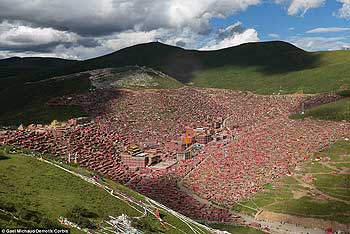By Becky Pemberton, The Daily Mail, 19 April 2015
 Larung Gar Buddhist Academy is home to 40,000 monks and nuns,
Larung Gar Buddhist Academy is home to 40,000 monks and nuns, who travel to the settlement of Sertar to study Tibetan Buddhism
Despite its secluded location it is home to the Larung Gar Buddhist Academy, the world's largest Buddhist settlement.
A vibrant splash of red, this colourful settlement has sprung up in the 1980s
and is now a haven for over 40,000 monks and nuns.
The sprawling settlement, Sertar, sits on elevations of 12,500ft, and the religious devotees battle harsh climates to study at the remote dwelling.
The wooden huts are built so closely together, they look like a red sea
spreading up the hilly terrain.
An isolated religious haven, Sertar is located around 370 miles from
Chengdu, and those wishing to visit have to travel by coach for a gruelling
20 hours. TVs are prohibited at the picturesque retreat, with monks and
nuns flocking to benefit from the studies, prayers and lectures ran at the academy. Photographer Wanson Luk journeyed to the secluded location
from Chengdu on a 20-hour bumpy coach ride.
The 34-year-old Buddhist said the Larung Area has two small guest houses,
but as these were occupied, he had to stay near the entrance.
He stayed two days at the Buddhist centre, taking part in ceremonies.
Luk said that the settlement welcomes everyone, and they maintain their
life in the hills from donations and by small businesses like the guest house
or small grocery store.
'I was most surprised about how people feel about death,' Luk said.
'I took part in the sky burial ceremony where there were hundreds or
thousands of condors waiting quietly. There were 7 corpses on that day...
one of them was a child.
'During the ceremony a monk will pray then the "sky burial master" will start cutting the corpses. When he is done, the condors will all fly to the corpses
'They believe the more the condors eat, the better it is and they will not eat
bad people's body.'
One encounter which struck a chord for Luk was the meeting of a nun who
was on her 'no speech day'.
When the photographer was asking how to get to the top of the hill for
night shots she resorted to all forms of gestures to try to assist. She ended
up taking him around the whole monastery, showing him how to spin the
prayer wheels and teaching him how to pray.
Although TVs are prohibited in the monastery, iPhones strangely are
permitted, with her typing words to instruct him as they went. Many
of the Buddhists own second-hand iPhone 4s.
The incredible academy was established in 1980 in the uninhabited valley
by Jigme Phuntsok, an influential lama of the Nyingma tradition.
Despite its remote situation, Larung Gar evolved from a handful of disciples
to be the largest Buddhist settlement in the world.
It attracts a mix of students from ethnic Chinese students to pupils from Taiwan, Hong Kong, Singapore, and Malaysia, who attend separate classes taught in Mandarin, while larger classes are taught in Tibetan.
No comments:
Post a Comment